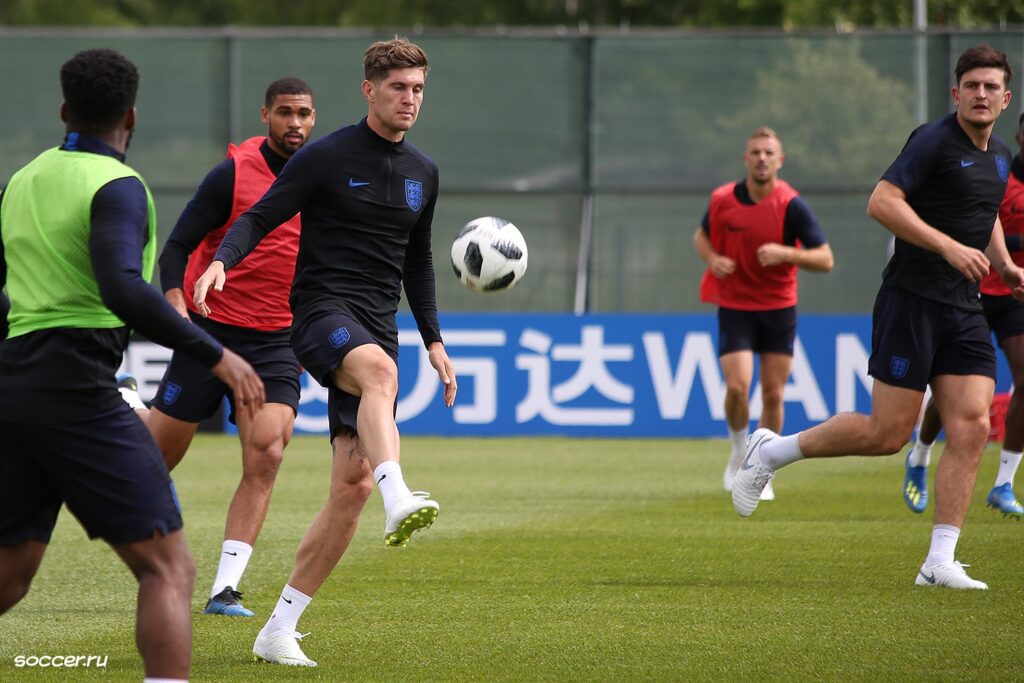5 Tips for Getting The Most Out of Soccer Training Sessions
Are you tired of going to soccer training sessions and feeling like you’re not making any progress? Do you feel like you’re putting in the effort, but not seeing the results you want on the field? If so, you’re not alone. Soccer training can be tough, but with the right strategies, you can make the most of your time and effort and see real improvement in your game.
In this blog post, we’ll share five essential tips for maximizing your soccer training sessions. These tips will help you optimize your training, set achievable goals, and track your progress along the way.
Also, make sure to read our in-depth guide on how to get better at soccer.
So, if you’re ready to take your soccer skills to the next level, keep reading!
Tip #1: Set Goals and Track Progress

This might just be the most important tip for youth soccer players. A lot of players these days half-ass their training sessions because they do not have any objectives set out for their sessions.
Setting goals and tracking your progress should be an important part of any effective soccer training routine. Without clear goals, it can be difficult to know what you’re working towards or whether you’re making progress. Here are some tips for setting effective goals and tracking your progress:
- Be Specific: Set goals that are clear and specific. For example, instead of setting a goal to “get better at dribbling,” set a goal to “improve my left-footed dribbling skills by practicing 30 minutes every day for the next two weeks.”
- Make Them Measurable: Your goals should be measurable so that you can track your progress. This will help you know whether you’re making progress and give you a sense of accomplishment when you achieve your goals.
- Write Them Down: Write your goals down and keep them somewhere visible, like on your phone or in a training journal. This will help you stay focused and motivated.
- Track Your Progress: To track your progress, you can use simple metrics such as time, distance, or repetitions. For example, if your goal is to improve your speed, you can time yourself running a certain distance (such as 100 meters) before starting your training. After each training session, repeat the exercise and time yourself again. You can track your progress by noting whether your time has improved or not.
Another example is tracking the number of repetitions for a specific exercise. If your goal is to improve your ball control, you can count how many times you can juggle the ball with your feet before and after each training session. By keeping track of your progress over time, you can see if you’re making improvements and adjust your training accordingly.
Tip #2: Focus on Proper Warm-Up and Cool-Down Routines
Proper warm-up and cool-down routines are essential for any soccer training session. A good warm-up routine helps to prepare your body for the physical demands of training, while a cool-down routine helps to prevent injuries and reduce muscle soreness.
Your warm-up routine should consist of light aerobic exercises, such as jogging or jumping jacks, followed by dynamic stretches that target the muscles you’ll be using during training. This helps to prepare your body for the physical demands of training, improve your range of motion, and prevent any injuries.
A good cool-down routine can also help prevent injuries and reduce muscle soreness. After your training session, take 5-10 minutes to cool down with some light jogging or walking. This helps to gradually lower your heart rate and prevent blood pooling in your legs, which can cause dizziness or fainting. You can also do some static stretches to help reduce muscle tension and soreness.
In addition to warming up and cooling down, it’s important to stay hydrated before, during, and after training to prevent dehydration and muscle cramps. Drink water regularly throughout the day leading up to your training session and bring a water bottle with you to drink during breaks.
By incorporating a proper warm-up and cool-down routine into your soccer training sessions, you’ll be able to improve your overall performance while reducing your risk of injury. Not only will this help you feel better during and after your training sessions, but it will also help you get the most out of your training in the long run.
Tip #3: Balance Technical Skill Development with Physical Conditioning

Soccer requires both technical skills and physical conditioning. It’s important to balance both aspects of training to become a well-rounded player. Here are some tips for balancing technical skill development with physical conditioning:
- Set Goals: Start by setting specific goals for your technical skill development and physical conditioning. For example, your technical skill goals might include improving your dribbling, passing, or shooting, while your physical conditioning goals might include increasing your endurance or speed.
- Create a Plan: Once you’ve set your goals, create a training plan that includes a balance of technical drills and physical conditioning. Your plan might include drills to improve your ball control, shooting accuracy, and passing skills, as well as exercises to improve your strength, speed, and agility.
- Mix Up Your Training: To avoid getting bored or plateauing in your training, vary your exercises and drills. For technical skill development, try new drills that challenge you in different ways, such as dribbling through cones or passing with your non-dominant foot. For physical conditioning, mix up your exercises to target different muscle groups and keep your workouts interesting.
- Seek Professional Guidance: If you’re not sure how to balance technical skill development with physical conditioning, consider seeking guidance from a professional coach or trainer. They can help you create a customized training plan that meets your specific needs and goals.
By balancing technical skill development with physical conditioning, you’ll become a more well-rounded player and improve your overall performance on the field. With a little planning and effort, you can achieve your goals and become the best soccer player you can be.
Also, you can try to improve your mental toughness as well during your training sessions. To learn more about how you can improve your soccer mentality, read our article on how to improve your mental toughness.
Tip #4: Practice Effective Teamwork Strategies

Soccer is a team sport, and effective teamwork is crucial for success on the field. When you train with your team, you should utilize these sessions to make sure that you’re improving your teamwork skills. Here are some tips for practicing effective teamwork strategies during your training sessions:
Communication
Communication is key in soccer. Make sure you and your teammates are communicating effectively on the field, whether it’s calling for the ball, providing feedback, or coordinating plays. Practice active listening and clear communication to ensure everyone is on the same page.
Understanding Roles
Every player on the field has a specific role to play. Whether you’re a defender, midfielder, or forward, it’s important to understand your role and how it fits into the overall team strategy. Practice working together to achieve team goals, rather than focusing solely on individual success.
Support and Encouragement
Encouragement and support can go a long way in building team morale and confidence. Celebrate each other’s successes and provide support during challenging moments. A positive team dynamic can make all the difference on the field.
Learn from Mistakes
Mistakes are inevitable in soccer, but it’s how you learn from them that matters. Encourage your teammates to learn from their mistakes and work together to improve. Avoid blaming or criticizing each other and instead focus on constructive feedback and solutions.
By practicing effective teamwork strategies during your soccer training sessions, you’ll be able to build a strong team dynamic and improve your overall performance on the field. Remember to communicate effectively, understand your role, support each other, and learn from mistakes. With a little effort and teamwork, you can achieve your goals and succeed as a team.
Tip #5: Make the Most of Limited Training Time

Sometimes, soccer training sessions are limited in time, whether due to scheduling conflicts or other factors. Here are some tips for making the most of your limited training time:
One way to maximize your training time is to focus on high-intensity drills that work multiple skills at once. For example, you could work on passing and shooting at the same time, or practice dribbling through cones while also working on your speed and agility. This allows you to work on multiple aspects of your game in a shorter amount of time.
Another way to make the most of limited training time is to prioritize your goals and focus on what you most want to improve. For example, if you’re struggling with shooting accuracy, spend more time working on your shooting skills during your limited training session.
It’s also important to come to your training session with a positive attitude and a willingness to learn. Even if you only have a short amount of time, you can still make progress and improve your skills.
Lastly, remember to rest and recover properly between training sessions. This allows your body to repair and rebuild, ensuring you’re ready for the next training session. Stretching and hydrating after each session can also help prevent injuries and improve your overall performance.
By making the most of your limited training time, you can still improve your skills and become a better soccer player. Focus on high-intensity drills, prioritize your goals, maintain a positive attitude, and rest properly between sessions. With a little effort and dedication, you can achieve your goals and succeed on the field.
Final Thoughts
Improving your soccer skills takes time, effort, and dedication, but the rewards are well worth it. By following the tips outlined in this article, you can get the most out of your soccer training sessions and become a better player.
Remember, soccer is a team sport, so effective communication, teamwork, and support are crucial for success on the field. Focus on developing both your technical skills and physical conditioning, and make the most of your limited training time by prioritizing your goals and staying positive.
Finally, don’t forget to enjoy the process and have fun! Soccer is a great way to stay active, build friendships, and learn new skills. With a little hard work and determination, you can achieve your soccer goals and become the best player you can be. Good luck!







